Impact of Personalized Recommendation on Today’s News Communication through Algorithmic Mechanism in the New Media Era
Abstract
In recent years, the continuous innovation of technology has greatly contributed to the great changes in the media industry. The rapid development of big data and artificial intelligence technologies has enabled people to transition from the era of new media to the era of intelligent media. While the automation of news production brings broad prospects for intelligent media, it also accelerates the challenge of information explosion. Facing the massive amount of news and information, how to get the information users want quickly has become a big problem. In order to solve the audience’s information anxiety, personalized news recommendation system is born. In fact, news gate-keeping is an important part of news distribution. In the era of smart media, algorithmic distribution has impacted the original distribution mode and brought challenges to news gate-keeping. Personalized news recommendation is one of the gate-keeping methods of intelligent media. At the same time, with the rapid development of the Internet and information technology, today’s society has entered a period of information explosion. In terms of news, the rapid development of the Internet has made it easier to publish and read news on the Internet. As a result, online news has become an important way for people to get information. However, the previous news websites had a large amount of news information, but only collected and consolidated the news. As a result, users were left to passively receive news information from news sites and find the content they needed. Consequently, although the Internet has a huge amount of complicated news information, it is unable to meet the diversified and personalized news needs of users. In order to solve this issue, researchers are constantly looking for solutions. The emergence of recommendation system is an effective measure to cope with the above problem. The mainstream models of recommendation systems are collaborative filtering model and content-based recommendation model. However, there are two essential problems with collaborative filtering. The first one is the cold start problem, and the second one is that the preference matrix of item users becomes sparse as the number of items and users grows. These two issues can seriously affect the recommendation accuracy of the recommendation system. As a result, a hybrid recommendation system is built by fusing common recommendation algorithms. This system can not only deliver personalized information to different users, but also compensate the shortcomings of a single algorithm to a certain extent. To be specific, the newly constructed hybrid recommendation system can push news of interest to users according to their demographic attributes, behavioral attributes, and interests, thus expanding the scope of news communication.
1. Introduction
With the development of media industry, access to news and information has become a crucial as well as indispensable component of people’s daily lives [1]. For instance, a cell phone or a computer can keep people informed of various events. However, the information explosion makes most people have information anxiety [2]. In this context, quick access to the information they want has become the core demand of the audience. Initially, search engines were able to satisfy users’ need to retrieve information to some extent [3]. Nevertheless, more than half of the search results are irrelevant to users’ needs, and people still need to search for what they want in the vast amount of search results. This model is time-consuming and does not always result in satisfactory information [4]. For example, a search for “Shanghai traffic accidents” may result in news about traffic accidents in the last month or even a year, but not specifically the news that the user needs. As a result, a new communication model of personalized news recommendation was created [5]. In fact, personalized news recommendations are made through algorithmic matching and manual review of user profiles and news descriptions to accurately recommend the news content users need to various users. As a result, it enables users to get effective information quickly [6]. In this paper, we emphasize the gate-keeping activities of news distribution from the perspective of news communication field. As a result, this study defines personalized news recommendation as a news dissemination model that uses algorithmic logic combined with human rules to customize personalized information needs and match distribution according to users’ interests and preferences [7].
At the same time, with the rapid development of the Internet in recent years, people’s access to news and information has become more and more convenient [8, 9]. With the popularization of information technology, the daily news resources of major news websites have increased dramatically [10]. However, the category navigation and search engine functions provided by websites have many drawbacks. As a result, the user experience of news websites needs to be improved in the face of increasing information overload [11]. News recommendation is one of the important ways to improve the quality of news service and optimize user experience [12]. With the rapid development of the all-media era, the number of daily online news sources also keeps growing. When these online news resources expand at a high speed, it will lead to information overload problem [13]. This means that users are unable to get the news they need or are interested in quickly and accurately when they are faced with a huge amount of news resources. At the same time, the platforms that provide online news services are unable to process and utilize the news resources in a timely and effective manner [14]. In order to improve the information overload problem, major online news service platforms provide section classification and search engine functions. For section classification, the complicated multilevel category navigation will reduce the quality of news services [15]. When users enter keywords in the search box to get the news they are interested in, they need to use the search engine with a clear purpose and ensure that the keywords are extracted accurately. In many cases, users do not have a clear purpose when using online news services. This requires the intervention of a recommendation system to recommend news information of interest to users, to achieve personalized news recommendations, and to improve user stickiness [16].
Recommendation systems are widely promoted in traditional Internet domains such as e-commerce and video. For example, on some major e-commerce sites, systems aiming to increase product sales can predict users’ potential purchase desires based on their historical data and thus push related products that users like and have more demand for [17]. In addition, some video sites use a recommendation system to suggest preferred videos for users. Various news media portals are categorized by topic, category, and content [18]. However, the system is not able to update news messages and adjust pages in real time. As a result, it does not meet the needs of users. The inherent characteristics of news lead to significant differences between news recommendations and recommendations from other domains [19]. In practice, recommendation systems also face many challenges. First of all, there may be no difference in the tags of different stages of the same event, but the corresponding specific news content is different [20]. In addition, different media sources have different perspectives on the same news. These factors contribute to the large number of news stories. Furthermore, timeliness is particularly important in news recommendation. To be specific, people are more likely to be aware of recent news rather than outdated news [21]. As a result, the news in the recommendation candidate set must be new. That is, they should never have appeared in the training set. At the same time, it is also important to consider that, in a highly commercialized environment, some malicious advertisements use keywords of hot news to increase their exposure [22]. Consequently, it is worthwhile to investigate how to eliminate these malicious advertisements and maximize the quality of news recommendations. In addition, when extracting news features, there are various forms of information that need to be processed [23]. This leads to heterogeneity of information, which makes it difficult to improve the performance of recommendation systems in a uniform framework.
Recommendation technology is still being updated as of today. So far, many recommendation algorithms have been proposed. However, it has been found that each recommendation model has its own scope of use and has some limitations [24]. For example, the item-based collaborative filtering model is a well-known approach in recommendation systems. However, this recommendation model still has some drawbacks because it has a cold start problem and poor performance in the case of preference matrix [25]. In addition, the algorithm tends to recommend news similar to those that the user has already read, which leads to low surprise in the recommended content [26]. The user-based collaborative filtering approach is also a very widely applicable recommendation model. Although the performance is great in terms of surprise of the recommendation results, the recommendation results are affected by popular items [27]. Implicit semantic and matrix decomposition models and their various improvements and upgrades are the best single-model approaches with the best accuracy. However, their computational performance decreases significantly when the amount of data is large [28]. As a result, there is a great difficulty in performing incremental updates, which leads to many difficulties in practical engineering. What is more, the implicit semantic model has difficulties in both adjustment and poor interpretability [29]. The basic idea of content-based recommendation algorithms is to recommend to users news similar to those they have already viewed. Nevertheless, in some public evaluations of the algorithm, it has not achieved satisfactory results [30]. Moreover, the algorithm is content-dependent, and the degree of description is generally limited by the degree of news content parsing.
Traditional recommendation algorithms do not fully meet the practical needs and can have one or another of the drawbacks. In this paper, we study the fusion of several recommendation algorithms. The fused recommendation system makes up for the shortcomings of a single recommendation algorithm and can push personalized information to different users. To a certain extent, this can solve the problem that users cannot get the information they need in time and effectively. Therefore, recommendation systems are a promising solution to the problem of information overload. In the field of news, recommendation systems use multiple characteristics of users as a basis to find content that is likely to be of interest to users in their behavioral data and push it to them. As a result, it can reduce the amount of time users spend searching for news. In order to address the above problems faced by news recommendation, this study converges different news recommendation algorithms. To be specific, this study adopts a relatively novel research idea from a practical application scenario. Based on real web news datasets, this research use improved traditional recommendation methods and deep learning methods to implement news recommendations in order to mitigate the impact of information heterogeneity on the recommendation system. At the same time, this paper aims to improve the information overload issue and proposes feasible technical solutions to improve the service quality of news recommendation.
2. Recommendation System for News Communication
The traditional way of news distribution makes the content consistent for each reader. The main reason for this is that the news published in newspapers or portals is divided into different sections based on news categories. As a result, the selection of news material is the same, and the editorial classification tends to be the same. The core problem of the recommendation system is how to mine user preferences and build a user profile model to predict user preferences. In fact, the recommendation system can dominate users and provide them with information in a high or low order. Therefore, it can develop users’ reading habits and thus guide their behavior, making them more and more dependent on the website and increasing their loyalty. The recommendation system makes it impossible for invalid information to accumulate in the user’s view. Most importantly, the recommendation system mainly solves the problem of information overload. At the same time, the user’s interests and preferences can be obtained from the user’s usage data, which can then be analyzed to recommend relevant information to the user. In short, a recommendation system is designed to ensure that the user’s personal needs are well met in the process of accessing information. This requires a recommendation mechanism between user needs and resources, which is the greatest value of the system.
2.1. Scrapy-Based Framework for News Dataset Collection
This study focuses on news recommendation. Due to the specificity of the application scenario of news recommendation, the final research objectives of different algorithms are different. As a result, the dataset for news recommendation research is also more specific. For example, news data come from a wide range of sources, and news recommendation emphasizes timeliness and heterogeneity of news information compared with other fields. After analyzing the needs of its own application scenarios, this study also proposes the types of news data needed. To be specific, this research will use a Scrapy-based web crawler for news data collection. A web crawler is a program script that crawls web data according to certain rules. In other words, web crawlers can simulate human browsing behavior to obtain information. The search engines that people often use can be thought of as having a large and complex web crawler in their system. To be specific, it can collect web information from servers around the world, put it together, and then sort and display it in the search results. The detailed principle of the web crawler is illustrated in Figure 1.

In fact, there are various crawler scripts for collecting data. Specifically, it is possible to write flexible crawler scripts using relevant library functions, or to use technical frameworks that are known for their efficiency. Considering the actual data requirements of this project, the Scrapy framework is applied for data collection in this study. Scrapy is an open-source crawler framework written in Python based on Twisted. Through continuous development, the Scrapy framework has become more and more sophisticated and is widely used in the field of data mining. As a result, it has provided strong technical support for many scholars to collect data. The basic architecture of Scrapy is shown in Figure 2.
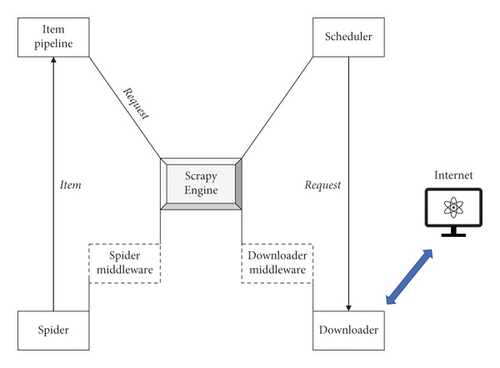
2.2. Collaborative Filtering Recommendation Technology
Collaborative filtering-based recommendation technology is one of the most widely used recommendation technologies. It does not care about user profile or item information, but analyzes user history data to explore potential connections between users and users or between items and items. Based on this potential connection, it can then predict the user’s interests and preferences. As illustrated in Figure 3, collaborative filtering recommendations are mainly divided into neighborhood-based and model-based. Neighborhood-based models are mainly divided into two subcategories, namely, item-based collaborative filtering and user-based collaborative filtering.

2.2.1. Item-Based Collaborative Filtering Recommendation
The initial commercial recommendation system that went live was a collaborative filtering recommendation based on items. By analyzing all users’ historical data, we can get users’ preferences for different items, and then explore the potential association between items. As shown in Figure 4, Item 1 is liked by User A, User B, and User C. Item 3 is also liked by both User A and User B. Item 3 is also liked by User A and User B at the same time. This situation means that Item 1 and Item 3 are most likely to have similar attributes. As a result, Item 3 is recommended to User C if User C likes Item 1.
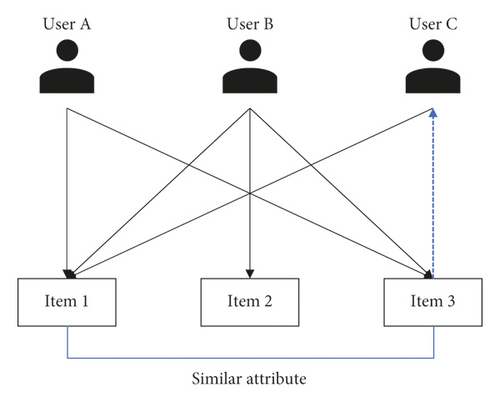
Therefore, the way to measure the item-to-item similarity is an important research direction. The cosine similarity algorithm is a proven algorithm and has been validated so far. In the case of news, there is a huge amount of news generated all over the world every moment. Moreover, there is a generalized reading characteristic in which users read and recommend each piece of news as an individual item. As a result, the accuracy of the recommendation results is very important. Similar items can be obtained by similarity calculation. Most of the similarity calculation methods are based on the vector form. In other words, the process mainly involves calculating the cosine similarity of two vectors. To be specific, the larger the value, the greater the similarity. In the case of item-based collaborative filtering, the behavior of all users towards the item is used as a vector for the representation of the item. The similarity between the two items is then obtained by calculating the cosine value between the two vectors.
In practice, this algorithm can be applied in scenarios where the frequency of change in the number of items is less than the frequency of change in the number of users. Although the algorithm has many advantages, such as simple and easy to extend, strong interpretability, and real-time can be handled better. What is more, this algorithm is highly respected in the field of e-commerce. However, in fact, item-based collaborative filtering recommendation is not suitable for the news field. To be specific, the similarity and relevance between items in different product categories are relatively stable. However, the similarity between news items is not stable because of the rapid iteration of updates. In other words, it is difficult to explore potential connections between different news items. As a result, due to these factors, it is relatively difficult for the algorithm to facilitate the development of news recommendations.
2.2.2. User-Based Collaborative Filtering Recommendation
The earliest online news recommendation systems can explore potential associations between users and users by analyzing historical user behavior data. As displayed in Figure 5, both User A and User C are interested in Item 1 and Item 3. As a result, it can be judged that the preferences of these two users are most likely to be similar. In other words, when User A is interested in Item 4, Item 4 will be recommended to User C at the same time.
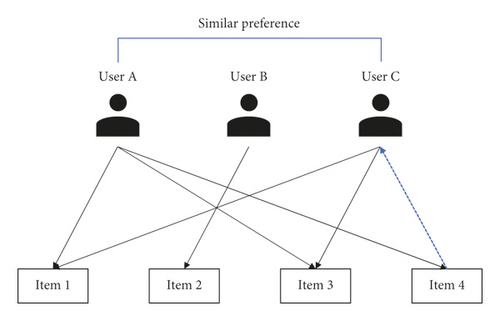
Item-based algorithms and user-based algorithms are created relative to each other, and they have different focuses. In fact, user-based recommendation algorithms mainly focus on searching for similar users and recommending things of similar interest to users that have concerns among them. Therefore, its logic is based on the analysis of different user behavior history data. After that, based on the analysis results, it can filter out users with similarities. Furthermore, it can recommend to the user the set of things that have high similarity and are not recommended. As a result, the main body of the user-based collaborative filtering recommendation algorithm is the similarity between various users.
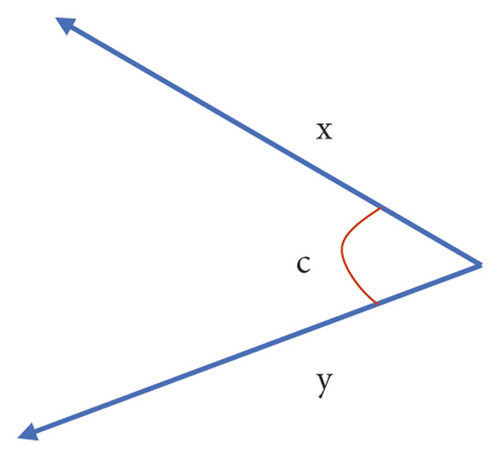
After that, the angle of the line segments is used to determine whether the contents are similar or not. When the angle is close to 0 degrees, i.e., when the angle is smaller, the two-line segments have the same direction or overlap. When the angle is close to 180 degrees, i.e., when the angle is larger, the two segments are in opposite directions. As a result, it is possible to determine whether two contents are similar by the angle of the line segments. In addition, when the angle is smaller, the two contents are more similar.
2.3. System Feasibility Analysis
Before a news recommendation system can be designed and developed, it must be analyzed for feasibility. If the defined problems cannot be solved by existing technologies, it will waste the human and material resources used for the development. In fact, there are many factors that affect the development of a recommendation system, such as time, resources, and technology. Therefore, a feasibility analysis is required to determine whether the system is worthwhile. This can avoid unnecessary losses. The feasibility analysis of recommendation system can generally be started from four aspects as shown in Figure 7.
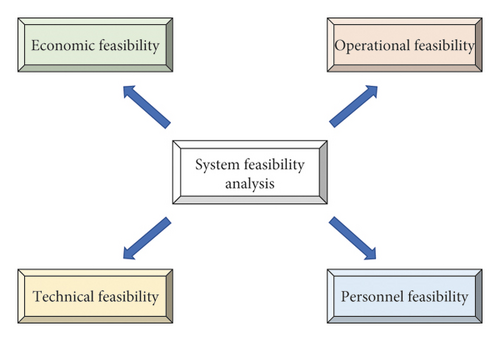
With the advent of the era of big data, computer technology has been developed rapidly. At the same time, the speed of data computation and data storage has also been greatly improved, which provides a strong technical guarantee for the implementation of the hybrid recommendation system for news. In terms of algorithms, this study investigates the current popular recommendation algorithms in detail and provides a detailed understanding of the implementation details, advantages and disadvantages, and application scope of each recommendation algorithm. The algorithms used for data processing were then investigated to select the data processing algorithms suitable for this system.
With the rapid development of Internet technology, people have slowly started to abandon the original way of news and turn to read online news. This is because the Internet makes it easier to get real-time hot news. At the same time, users can express their opinions about the news and communicate with others. This provides a relaxed and free reading environment. Compared to the original news method, the mobile news software now saves a lot of manpower and costs. Most of the software used in the development process can be obtained from the Internet. As a result, the capital investment in the process is low and the development costs are low. In terms of benefits, the recommendation system can recommend content of greater interest to the user. This increases the user’s favorability, which in turn increases the retention rate of the news portal, among other indicators. As a result, this system is economically viable.
The first consideration in the design of the news recommendation system was a friendly interface. In addition, this system was developed on the principle of simplicity. In other words, first-time users and administrators are able to familiarize themselves with the process in a short period of time. This enhances the user experience and facilitates efficient operation. In summary, the system is operationally feasible. Moreover, this system is designed with a user-friendly interface and simple operation. As a result, users can get the appropriate recommendations just by browsing normally. This greatly enhances the user experience and attractiveness. Therefore, the news recommendation system is feasible for people.
2.4. System Functional Requirements Analysis
The users of the system are the users and the administrators. The system was designed to be divided into several modules, which reduces the coupling of the system and allows each module to meet its own business needs. The key business is to provide users with personalized recommendations to improve user satisfaction and favorability. The next three aspects of the business requirements are introduced from the mobile terminal, recommendation subsystem, and backend management.
Users can browse and recommend news through their devices. The recommendation subsystem can recommend news to users based on their behavior and their demographic attributes. The backend management system is mainly for managing news and users. In the mobile device, the modules include registration module, login module, interest selection module, interest management module, news display module, and behavior action module. The recommendation subsystem includes news acquisition module, user behavior collection module, news content preprocessing module, user behavior log preprocessing module, user portrait module, and recommendation module. The backend management module includes news attribute management module, administrator attribute management module, news publishing, and content management module. Each functional module cooperates with each other and works together. Each functional module cooperates with each other to complete the recommendation work.
After getting the news, we cannot use it directly, but need to carry out the corresponding preprocessing module. Because of the huge amount of news that we get every day, the quality of news varies. If users are presented with low quality news, it will seriously affect their experience and lead to user churn. Therefore, it is necessary to judge the quality of articles and eliminate the low-quality news. At the same time, it is not guaranteed that the attributes are fully populated when adding news. Therefore, it is necessary to fill in the attributes through data preprocessing to provide complete and accurate data for the later calculation.
In fact, the news recommendation module is the core module of the system. Because the user’s demographic and behavioral attributes are used to make appropriate evaluation.
The recommendation module is the core module of the system. It is through the recommendations that we can provide personalized information to users and improve the user experience, thus increasing the usage of the system. This system can query the user’s behavior log through the database. Furthermore, by analyzing the user’s behavior, we can obtain a user profile and combine it with the user’s demographic attributes to obtain a more complete user profile. After that, a feature vector can be obtained by transforming the user’s features. The user’s feature vector and the content in the news pool can be recalled with the help of the developed recall strategy, and then the candidate news collection can be obtained. After that, the news collection is filtered to obtain the initial recommendation results. Finally, the final recommendation result and recommendation explanation are obtained by sorting operation. In fact, this ranking can be adjusted by the feedback of user behavior to obtain a personalized recommendation system, which provides an intelligent environment for users.
3. Conclusion
Nowadays, with the popularity of Internet technology, people can get news information more and more quickly. As the Internet becomes increasingly rich in news, news recommendation systems have emerged and become one of the research hotspots for many scholars. In this study, we aim to alleviate the impact of heterogeneity of news information on news recommendation systems and fully explore the benefits of user feedback behavior on recommendation systems. In fact, news covers increasingly complex forms of information. In addition to the common textual forms, there may be pictures, videos, links, and so on. Therefore, a single form of information is not enough to characterize the news fully and accurately. The heterogeneity of information forms makes it too tedious to extract news features from all information forms. As a result, this study proposes a collaborative filtering recommendation algorithm. The algorithm avoids the heterogeneity of information by timely mining users’ feedback behaviors on news. At the same time, it can characterize news features to achieve news recommendation.
However, in real application scenarios, users have very different preferences. Moreover, the mapping of sections to vector space will also belong to a higher dimensional space. Therefore, as the size of users grows, the vector classification of user behavior must be relatively large. In future research, the algorithm proposed in this study can be validated on larger scale data.
Conflicts of Interest
The author declares that there are no conflicts of interest.
Acknowledgments
This work was supported by the Anshan Municipal Committee Party School of CPC.
Open Research
Data Availability
The labeled dataset used to support the findings of this study is available from the author upon request.




